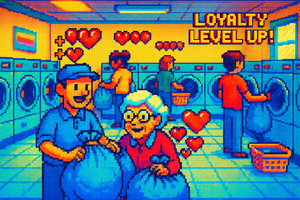Ten blocks apart in Brooklyn, two laundromat owners faced the same threat last October. A venture-backed laundromat opened between them. Brand new equipment, slick app, marketing budget that made the other laundromats budget look like pocket change.
Owner A responded like any smart businessperson would. Upgraded equipment, launched a $4,500 monthly digital marketing campaign, tracked every metric. Turns per day, average transaction value, peak usage hours.
Owner B kept doing what they'd always done, just leaning in a little bit more. Their attendant Maria continued sitting with clients during the dry cycle, but now made sure to remember the details like Mrs. Chen's daughter's college applications, Mike's new night shift schedule, the Martinez family's weekend soccer tournaments. They maintained their $650 monthly budget for community events and celebrations when the local youth team won, evening concerts with neighborhood bands, partnering with a church to run a weekend food pantry.
Six months later, Owner A had lost 40% of their clients despite having newer equipment and spending more on marketing. Owner B retained 90% of their clients base with ten year old well maintained machines.
What happened?
The Business of Creating Customers
Peter Drucker figured this out in 1954. In "The Practice of Management," he wrote that the purpose of a business isn't to make money, it's "to create and keep a customer."¹ Profit, he argued, is the result of doing that well, not the goal itself.
This isn't a feel good philosophy. It's a proven strategy that built empires. Starbucks didn't become ubiquitous by having the best coffee; they created a 'third place' between work and home where customers belonged.² Nike doesn't just sell shoes; they built digital platforms and community channels that transform customers into members of a movement.³ Coca-Cola doesn't just distribute beverages; they position themselves wherever customers are, in whatever form customers need.⁴
These billion dollar companies understand what Owner B intuited, customer creation happens through belonging, not transactions. Read that again.
When Life Happens
Three months after the new laundromat opened, life threw both businesses a test.
At Owner A's laundromat, Mr. Smith mentioned his son broke his leg during basketball practice. His son would be on crutches for two months. Owner A's response was textbook customer service. Posted on social media about supporting families through tough times. Offered Mr. Smith a 20% discount on their wash-and-fold service. Transaction completed, compassion checkbox marked.
At Owner B's laundromat, Mrs. Chen's husband had a stroke. She was suddenly handling all household tasks alone while managing daily hospital visits. The Tuesday morning regulars already knew, and mentioned it to Maria. She tells Owner B when they stop by to check on the store. They mail a get well card signed by the team to Mr and Mrs. Chen, Maria and the other attendants help Mrs. Chen fold clothes during down time, Owner B lets the owner of the local supermarket know what has happened. He arranges to have their groceries delivered for free until Mr. Chen is out of the hospital.
The difference? Mr. Smith got a discount. Mrs. Chen got a community.
The Invisible Advantage
Here's what Owner A never understood. Those two hours clients spend waiting aren't dead time, they're relationship building time. When Owner B's staff helps carry bags to cars, they learn about graduations, new grandchildren, job changes, divorces. They notice the baby seat that appeared last month, the camping gear that shows up every third weekend, the dog blanket that needs extra cleaning.
This isn't data you track in spreadsheets. It's knowledge you gain by seeing your business as Drucker did, not as a series of transactions, but as a practice of creating and keeping customers through genuine human connection.
Owner A knew that Machine #7 ran twelve cycles yesterday. Owner B knew that Mike switched from Tuesday to Saturday washes after starting night shifts. Owner A could tell you average cycle times. Owner B could tell you whose grandson just graduated.
Guess which knowledge mattered when clients had to choose between three laundromats?
The Numbers Don't Lie
Research consistently shows that increasing customer retention by just 5% can increase profits by 25% to 95%.⁵ Why? Because retained clients don't need marketing dollars to bring them back. They become advocates. They bring friends. They forgive occasional problems. They become part of the business's story.
Owner A spent $27,000 on marketing over six months to lose customers. Owner B spent $3,900 on community events to keep them. The ROI isn't just different, it's inverse.
Thinking about the thinking of laundry:
When you realize clients don't choose where to wash clothes but where they belong, you stop competing on what you have and start competing on who you are.
The Monday Morning Question
Walk into your laundromat on Monday. Don't look at the machines first. Look at your clients. Do you know their names? Their stories? Their struggles?
The path to Owner B starts with a simple shift. Stop seeing those waiting hours as dead time. Start seeing them as exactly what Drucker understood them to be, the moments when clients are created.
That's all I got for you today.
Waleed
Echoing the thoughts of Maya Angelou.
People will forget what you said, people will forget what you did, but people will never forget how you made them feel.
Footnotes:
¹ Drucker, P. (1954). The Practice of Management. Harper & Brothers.
² Starbucks Customer Experience Strategy
³ Nike's Community Engagement Model
⁴ Coca-Cola Customer-Centric Segmentation
⁵ Harvard Business Review: The Value of Customer Retention





